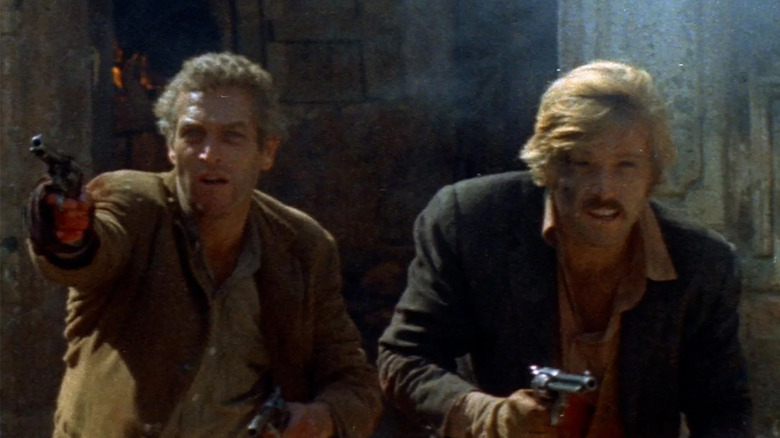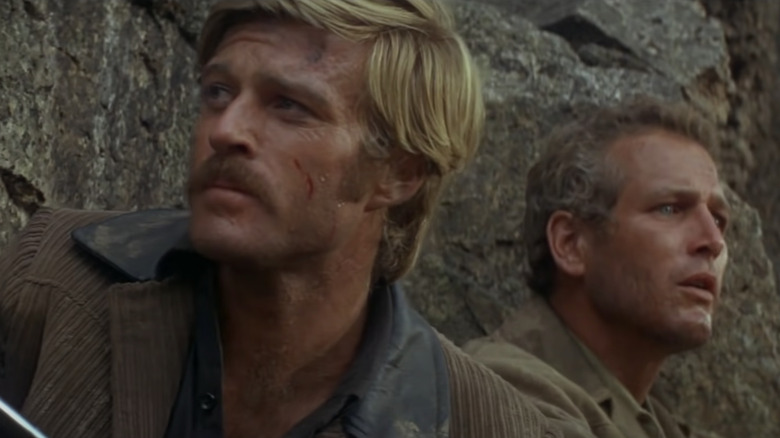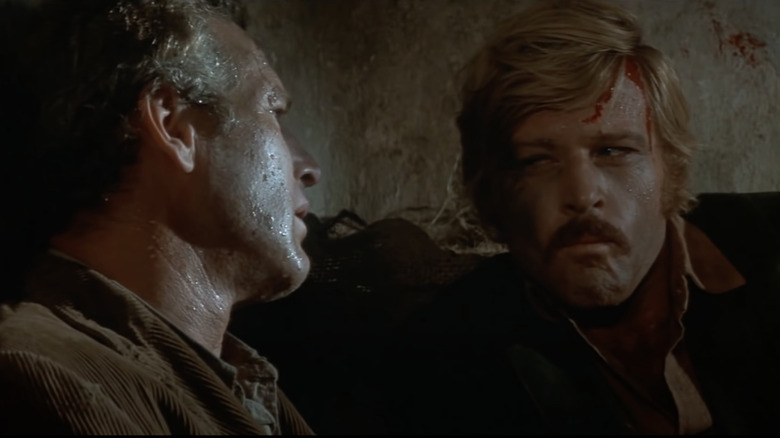The Butch Cassidy And The Sundance Kid Alternate Ending That Thankfully Wasn't Used
One of the key jobs of a director is tone management. You could argue it is the most important. Making sure nothing that occurs in a film feels outside the bounds of what the vibe of the picture is meant to be can be enormously difficult. One false move could really sink the entire thing, and this is especially true of an ending. Plenty of movie endings out there are made by people who have misjudged what their film's tone has been up to that point. They feature an ending so discordant from the proceeding 90-or-so minutes that you regret the time spent watching it. It takes someone with a keen eye to recognize a moment has gone off the rails and find the wherewithal to correct it.
Such was the case with "Butch Cassidy and the Sundance Kid," the rollocking good time buddy Western starring Paul Newman and Robert Redford. George Roy Hill's film that topped the box office in 1969 features one of the most iconic endings in Hollywood film history. Newman and Redford, on their last legs, charge into a shootout. The film then freezes, and we hear the sound of a barrage of gunfire as the freeze frame fades to a sepia tone. While this ending is beloved now, it was not the way "Butch Cassidy and the Sundance Kid" was originally supposed to end.
Shouldn't It Be Fun?
"Butch Cassidy and the Sundance Kid," at its core, is a romp. Paul Newman and Robert Redford are two megawatt movie stars who have delicious banter and commit crimes. We like these guys, so we're on board for just about anything they want to do. It is lighthearted, crowd-pleasing moviemaking of the highest order. I mean, one of the most iconic scenes from the film is Paul Newman's Butch riding around on a bicycle with Katharine Ross as Burt Bacharach's "Raindrops Keep Fallin' on My Head" plays on the soundtrack. What could be more warm-hearted and fun than that?
All that being said, the original ending was nowhere near as chipper. Instead of that freeze frame shootout, we were going to see our two titular heroes mowed down by the Bolivian Army. These two fun-loving scamps filled with bullet holes. Talk about a far cry from Burt Bacharach.
It would be one thing if the design of "Butch Cassidy and the Sundance Kid" was as a tragedy. Seeing their deaths would have been this fitting, sad ending that felt inevitable, along the lines of Arthur Penn's "Bonnie and Clyde" from two years earlier. But George Roy Hill wasn't making that kind of movie. He made a fun, on-the-run crime movie. We like seeing Newman and Redford get out of a jam, and them meeting a definitive end would have felt wrong.
Hope in a Hopeless Place
The freeze frame at the end of "Butch Cassidy and the Sundance Kid" gives the audience a glimmer of hope. Maybe Butch and Sundance did make it out of there and weren't riddled with bullets. They made it to their horses and rode off into the sunset. Of course, this did not actually happen, but it gives us at least the hope of possibility. Before the two charge out to their presumed deaths, they are still quipping with each other and making light of the situation, even though they know their time is short. That lightness transfers onto us and puts smiles on our faces. We want to believe they will make it out alive.
Positivity and likability are powerful tools when used properly. They can make us care for people we normally wouldn't in real life. Butch and Sundance are thieves, but because of George Roy Hill's command of that positive tone, we adore them. Hill re-teamed with Paul Newman and Robert Redford a few years later for the con artist film "The Sting," which was another immensely likable movie about normally unscrupulous people. It was the second highest grossing film of its year (behind a little movie you may have heard of called "The Exorcist") and even won Best Picture. These three people working together understood how to weaponize charm to please every single person entering the theater.
Had they kept the original ending to "Butch Cassidy and the Sundance Kid," they very well could have crushed all the good will built up from the audience up until that point. It could have turned off people from coming back again and again to see it, and it wouldn't have become the cultural phenomenon it did. Luckily, sense prevailed, and we can watch Butch and Sundance over and over again, always hoping that they get away this time. When the film was going to star Steve McQueen instead of Robert Redford, that original ending would have worked better, but certainly not for the film we have.


